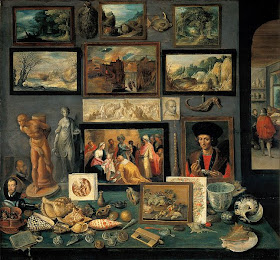Last December Israel "Iz" Kamakawiwo'ole was named one of the 50 great voices on NPR. This was one of a vast number of accolades given to the man, most of them posthumously. When he died at age thirty-eight he was honored by having his coffin lay in state at the Capitol building in Honolulu - the third person so distinguished and the only non-government official. His funeral was attended by over 10,000 people, and the state flag flew at half-mast, so beloved was he.
Born three months before the Hawaiian Islands became the 50th state of the U.S. in 1959, he was and is heard all over the world. His father was a bouncer and his mother managed a club where he was exposed to a variety of musicians and entertainers. He became known at an early age as "the kid with the ukelele" and was often called on stage to jam.
 |
| Iz with the Makaha Sons at the 1982 Hoku Awards. Image courtesy of KGMB. |
Along with his brother Skippy, Louis "Moon" Kauakahi, Sam Gray, and Jerome Koko, Iz became part of the Makaha Sons of Ni'hau. The group gained popularity as they toured Hawaii and the mainland from 1976 into the 1980s. They released fifteen successful albums.
 |
| Iz with the Makaha Sons. Image courtesy of KGMB. |
In 1982 his brother Skippy died of a heart attack. That same year Iz married his childhood sweetheart, Marlene. They later had a daughter whom they named Ceslie-Ann "Wehi". Knowing his lifetime would be brief, he packed a lot into the years he had.
 |
| With daughter (l) Ceslie-Ann and wife Marlene. |
The Makaha Sons of Ni'hau became Hawaii's most popular traditional music group. Their top-selling album was Ho'oluana, and that was Iz's last with them. In 1990 he released his first solo album Ka'Ano'I. This album won awards for Contemporary Album of the Year and Male Vocalist of the Year from the Hawaii Academy of Recording Arts (HARA).
 |
| Image courtesy Betty Stickney/Honolulu Advertiser. |
The album Facing Future was released in 1993, and it debuted #25 on Billboard's Top Pop Catalogue chart. In October of 2005 it became Hawaii's first certified platinum album, selling over a million CDs in the U.S. It featured his famous medley of "Somewhere Over the Rainbow/What a Wonderful World". In 1994 he was voted "Favorite Entertainer of the Year" by HARA.
In 1997 he was again honored by HARA at its Annual Nā Hōkū Hanohano awards for the "Male Vocalist of the Year", "Favorite Entertainer of the Year" again, and "Island Contemporary Album of the Year". Unfortunately he had to watch the awards ceremony from a hospital room. On June 26, 1997 he died of weight-related respiratory illness.
 |
| Image courtesy of Craig T. Kojima/The Star-Bulletin. |
He had always struggled with his weight - top recorded weight was 757 pounds, and he was 6'2". Most of his immediate family had died relatively young of complications from obesity. He told his friend and producer, Jon de Mello:
I was scared when I lost my mother, my father, my brother,
my sister. I guess this is gonna sound kind of weird, but I'm
not scared for myself for dying. Because I believe all these
places are temporary. This is just one shell. Because we
Hawaiians live in both worlds. It's in our veins. When our
time comes, don't cry for me. Don't cry for me.
He was aware that he had limited time. His sound engineers were told to keep the tape rolling for all of his rehearsals. Although he no longer existed physically, his popularity soared. The use of his music in television commercials and shows like ER, as well as films such as Meet Joe Black, Finding Forrester, and Fifty First Dates led to more exposure and widened his fan base. When authors began to cite him it was clear he had attained celebrity.
His album Alone in Iz World (2001) debuted at the #1 spot on Billboard's World Chart and #135 on Billboard's Top 200, #13 on the Top Independent Albums Chart, and #15 on the Top Internet Album Sales Chart. His famous medley passed the 2 million paid downloads mark in the U.S. in September 2009.
Last year "Over the Rainbow" was #1 on the German singles chart, was #1 seller single of 2010, peaked at #6 on the OE3 Austria charts, and became #1 in France and Switzerland. It was certified 2x Platinum this year.
 |
| His wife Marlene with a bronze portrait sculpture at the Waianae Neighborhood Community Center. Image courtesy of Jan-Michelle Sawyer/Around Hawaii. |
Known for his promotion of Hawaiian rights and independence through his lyrics and his life, this man was given the burial due the king that he was. Childhood friend Del Beazley was among the people who were on the traditional Hawaiian voyaging canoe that carried his ashes to be scattered in the Pacific Ocean. Beazley described big semi-trucks on the island blowing their air horns, echoing out to the canoe. He likened it to when the mo'I or "king" passed away and the people would wail. Thousands stood on the shore that day to pay their last respects.
But he lives on...
***************
Unless otherwise stated, images courtesy of
his official website.
*******************************




































